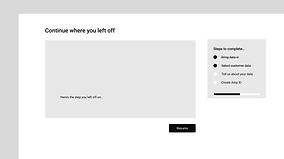Quick start modular onboarding
My role: Lead Designer
Partners: 1 Product Manager, 3 Engineers, ¼ UI Designer
Timeline: 1 month

Business context
The business faced a 500-day sales cycle with a sparse pipeline, requiring a much faster opportunity generation. Shifting focus to technical "builder" users, the company aimed to simplify onboarding and transition from a service-led model to a self-service product, emphasizing end-to-end user experiences over feature depth.
Challenge
Onboarding was overly complex and relied on expert-level knowledge of the system. Transitioning from a service-led model to a self-service model would accelerate the sales cycle and get prospects into the pipeline faster.
Key objectives
-
Ship a free trial motion in 1 month
-
The free trial must allow users to configure their identity resolution in less than 3 hours.
Collaborative Strategy & Ideation
With just one week to deliver wireframes, I led a collaborative workshop with my PM partner to align on the overall strategy and clarify key details. I began by mapping the end-to-end task flow for identity resolution setup while identifying pain points and areas for improvement.

I designed a streamlined, self-contained setup module that leveraged AI to automate repetitive tasks and focused on improving user understanding of the product. This guided us toward restructuring some of the existing systems.

I paired with my PM to validate the proposed changes with real client use cases, confirming that the new structure made it significantly easier to understand the purpose of each identity.
To minimize risk, I also recommended launching the quick start trial as a new tab, allowing us to roll out the feature to select trial tenants without impacting existing clients.
This approach gave us the flexibility to experiment with the information architecture for this feature—stay tuned for the upcoming case study where I’ll dive into our site IA overhaul.
Design Solution
No-knowledge setup experience: requires no prior training or product knowledge, drastically lowering the barrier to entry for users and enhancing accessibility.



Informative: Modular steps and requirement panels educated the user about system dependencies and requirements. The task-based flow removed distractions and guided the user through an iterative process of: set up, evaluate, and fix.


AI-powered: Leveraging AI to automatically locate customer data and apply semantic tags, streamlining complex processes and enabling even expert users to focus on higher-value tasks like evaluation and adjustment.



Outcomes
Our first few users tried the quick start module with no prior training and were able to complete the entire flow in under 3 hours, including the workflow time.
This dramatic reduction in time showed how the new approach made onboarding faster, more efficient, and easier to navigate.
Prior to quick start module:
-
40 hours of training
-
No guidance in platform for where to start
-
No guidance in platform for next steps
-
No guidance for evaluating identity resolution success
-
Support tickets filed and hours spent waiting for answers
“I was able to complete the entire guide in about 52 minutes, including about 38 minutes of workflow time.”
– User 1
“Mine took about 2.5 hours…that includes reruns.”
– User 2
Project strengths

Test strategy early
We were able to move fast by focusing on alignment and testing our direction early with stakeholders.

Iterative polish
Dev started with wireframes and we were able to get a full working prototype in 1 sprint. We then continued to refine the UI in small chunks.




